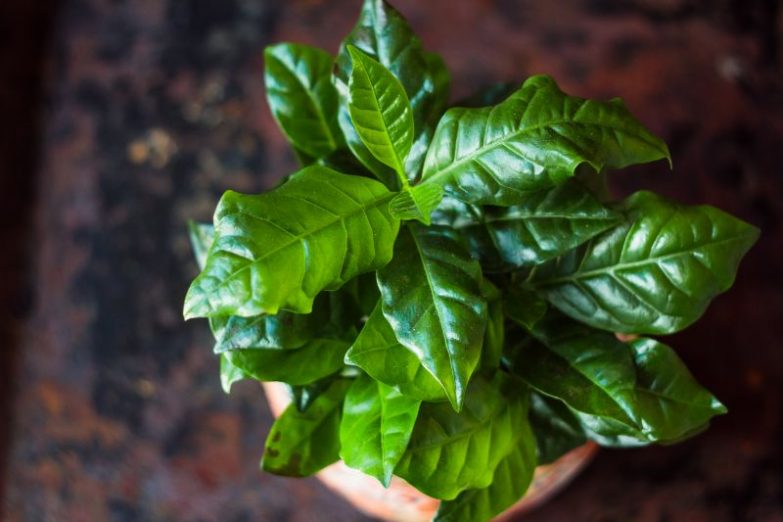The Coffee Plant (Coffea arabica) produces the invigorating beverage loved all over the world, and it also makes an attractive and easy-to-grow houseplant. It adds a fun dimension to your collection and is a great conversation starter. Let’s take a look at how to care for this famous plant.
High humidity, bright indirect light, and moist, rich, well-draining and slightly acidic soil are the most important aspects of Coffee Plant care indoors. Provide mild temperatures between 65ºF (18ºC) and 80ºF (27ºC), fertilize every 2-4 weeks during the growing season, and monitor for pests.
Overview Of The Coffee Plant (Coffea Arabica)
The Coffee Plant originated in the highlands of Ethiopia and South Sudan, where it grows on rich, well-draining earth beneath a forested mountainside canopy. It’s a tall, long-lived evergreen shrub that grows robustly throughout the steamy warm season.
The Coffea arabica is a member of the Rubiaceae family. It resembles its relative, the Gardenia, and has waxy, glossy dark green leaves with ruffled edges that grow upright on sturdy canes.
The plant blooms with small, fragrant, white flowers in the spring. The resulting berries slowly ripen from green to a glowing red. These berries contain the seeds, or coffee beans (which are actually a fruit). Coffee Plants don’t begin producing berries until their third or fourth year.
Grown outside in favorable conditions, the plant can grow into 40-foot tall tree; they are, however, amenable to pruning to a smaller size as a houseplant. Professional coffee growers typically keep their trees from four to six feet tall for convenient harvesting.
Coffee Plant Care Summary
| Scientific Name | Coffea arabica |
| Origin | Ethiopia and South Sudan |
| Light Requirements | Bright, indirect light. Will do best close to an east or west-facing window. A little early morning or late afternoon direct light is ok. |
| Watering | High water requirements. Water thoroughly once the top half-inch of soil feels dry. Avoid soggy soil and ensure the pot has good drainage. |
| Soil | Well-draining, slightly acidic soil, rich in organic matter. A mix of two parts peat, one part compost and one part perlite is a good option. |
| Temperature | Maintain a temperature of between 60ºF (15ºC) to 80ºF (27ºC). Nighttime temperatures as low as 46ºF (8ºC) are fine, but they’re not cold hardy. |
| Fertilizer | Coffee plants do best when fertilized regularly. A balanced blend applied every 2-4 weeks during the growing season and every 1-2 months during the autumn and winter is great. |
| Humidity | Coffee plants do best with humidity of >50%. They will tolerate lower levels, but won’t look their best. |
| Flowering | Produce clusters of fragrant, star-shaped, jasmine-scented white flowers each spring once they reach two or three years old. |
| Pruning | Regular pruning is required to control their height and will help them produce more bushy growth. |
| Propagation | Most easily propagated from seed, but cuttings can be propagated with some care and attention. |
| Re-Potting | Coffee plants grow quickly and can easily become rootbound. Repot every 2-3 years, but only increase the pot size by 1-2 inches at a time to prevent issues with overwatering. |
| Diseases and Pests | Coffee plants are susceptible to all normal houseplant pests. Regular inspection and prompt treatment are crucial. Coffee Leaf Rust is a particular issue, and prevention is key. |
| Toxicity | Coffee plants are toxic to humans and pets. |
| Where To Buy | Buy a Coffee Plant online at Etsy (I buy most of my houseplants from Etsy). |
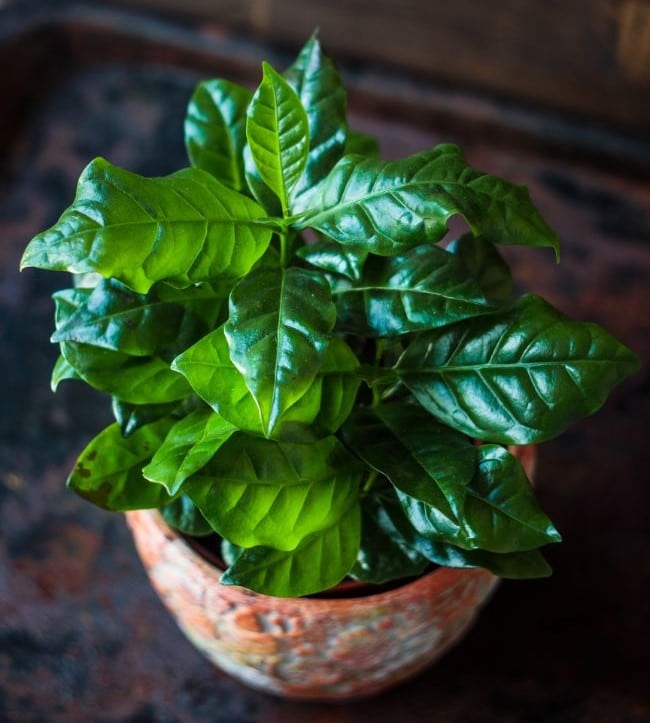
Coffee Plant Light Requirements
As a plant that naturally grows in bright forest shade, the Coffea arabica needs strong indirect light. It will scorch in harsh direct sun and quickly develop brown leaf spots and edges.
Indoors, they prefer a location close to a bright window. They do well with a few hours of gentle morning sun: an east-facing window is often ideal.
Outdoors, they can adapt to about four hours of filtered sunlight daily … if you’re in a latitude with weak sun, they can take more hours of fuller exposure. Coffee Plants do well in artificial lighting, too.
How To Water An Indoor Coffee Plant
The Coffee Plant is a fairly thirsty plant that likes more water than you might expect. You never want it to let it sit in soggy soil, but you’ll probably need to water at least weekly during the warm season. The plant uses less water in cool weather, so adjust as needed. Watering is the most common cause of Coffee Plant care problems, so read my houseplant watering tips to make sure your plant keeps thriving.
One reason this is a good beginner’s plant is that it droops to let you know when it needs water – but don’t wait for wilting before you water! The plant will bounce back quickly, but it’s not a healthy practice to let it wilt regularly.
The best way to water is to soak the soil and let the excess drain out. This helps cleanse the soil of residue fertilizers and ensures the soil is thoroughly hydrated.
Let the top half-inch dry before rewatering, but don’t allow the soil to dry out completely. Ideally, the plant likes steady moisture around its rootball, but letting the surface dry helps keep it from becoming waterlogged.
Coffee Plant Soil Requirements
The soil for your Coffee Plant must provide nutrition and have enough structure to stay open and aerated after watering. There are many possible ingredients that can make a suitable mix.
The soil should have these qualities:
Excellent Drainage – Keeping the roots moist and well-oxygenated requires soil that drains exceptionally well. Consider the plant’s natural mountainside habitat: there’s not much stagnant water on sloping terrain, and it needs similar conditions as a houseplant.
Fertility – Coffee Plants grow best in a rich medium with ample organic matter.
Slightly Acidic pH – The best soil pH is a mildly acidic 6 to 6.5; a lower reading is better than one above this range. One reason organic material makes a suitable soil component is that it gently acidifies as it breaks down.
One good recipe is two parts peat, one part compost, and one part perlite. Alternatively, two or three parts of a retail cactus mix to one part organic matter will work well. The addition of inorganic aeration materials like coarse sand, perlite, or pumice will improve drainage and aeration.
Humidity
Though you might get away with average conditions, the Coffee Plant care is much easier when you provide higher humidity. It’s used to steamy conditions back home.
If the humidity is too low, the plant won’t necessarily die, but its foliage is likely to brown on the edges and tips. The plant will be glossier and healthier with humidity of 50% and above.
If your home’s air isn’t extremely dry, pebble-filled water trays near or beneath the plant might make up the difference. Consider using a room humidifier as an industrial solution to fix very low humidity.
Don’t bother misting, though. It doesn’t last long enough to make a difference and can open the leaves to fungal problems.
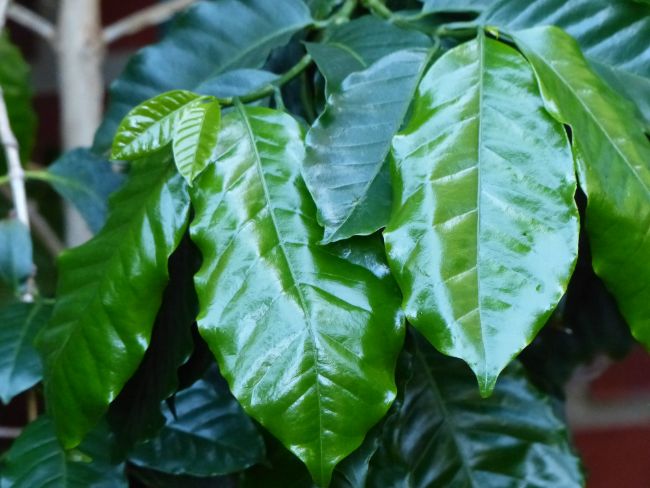
Coffee Plant Temperature Requirements
Coffea arabica is considered a warm-weather plant, but it doesn’t like to get too hot. High temperatures above 80ºF (27ºC) can impede photosynthesis by closing the plant’s stomata. This is actually an increasing problem for outdoor growers: hotter conditions are a threat to worldwide coffee production.
The best range is from 60ºF (15ºC) to 80ºF (27ºC). Nighttime temperatures as low as 46ºF (8ºC) are fine, but they’re not cold hardy – a frost will kill them quickly. Be sure to keep the plant out of both hot and cold drafts.
The plant can grow outdoors year-round in USDA Zones 10 and 11.
Fertilization
To be all they can be, Coffee Plants need fertilization through the warm season. Taper to smaller, infrequent amounts over the winter.
Ideally, their feeding regimen is a supplement to an already fertile soil.
A typical schedule is to apply fertilizer every two weeks during the growing period, switching to monthly applications over the cool season. A liquid form is the most convenient for measuring, and it disperses evenly through the soil. Coffee Plants respond to foliar feeding, too.
A balanced blend like a 10-10-10 NPK ratio can work well, but professional growers often supply a higher percentage of nitrogen (N) along with some extra potassium (K). Dilute the fertilizer to half the label’s recommendation. Read my guide to fertilizing houseplants for more info.
Here are the primary nutrient requirements and signs of deficiency:
Nitrogen – The most critical macronutrient. A plant with a healthy supply of nitrogen has lush, dark green leaves; too little results in pale or yellowing foliage.
Potassium – This element aids berry development. A deficiency can cause brown spots on leaves, especially older ones.
Phosphorus – Needed for production of roots and buds, a lack of phosphorus may cause yellowing or give foliage a bluish tint.
Micronutrients – Small amounts of additional nutrients that support plant functions may need to be supplemented. Acidic soils are especially prone to iron deficiency.
Fragrant Flowering
Specimens begin to bloom with clusters of fragrant, jasmine-scented white flowers each spring once they reach two or three years old. They generally become productive by their fourth year.
Each white flower is small and star-shaped, and will produce a ½-inch green berry that darkens as it ripens. Each berry produces two seeds, or “beans.”
The flowers don’t need to be hand pollinated to produce berries. Once berries appear, the plant is beginning a production prime which lasts about ten years … though the plant can live another fifty years.
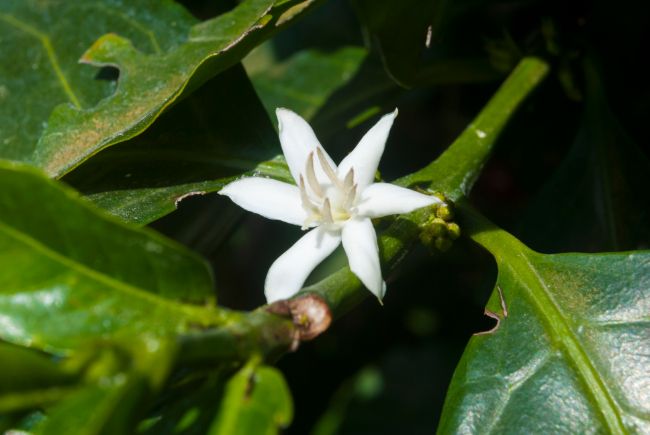
Coffee Plant Pruning
Coffee Plants can grow upwards of 30 feet tall, so it’s necessary to prune them periodically. Trimming can also extend their productive lifespan.
Pruning is an important aspect of Coffee Plant care indoors, and they usually respond by producing healthy, bushy growth. You can pinch back a young plant and graduate to using hand pruners as it grows.
The most common pruning you’ll do is to trim the top foliage to limit the plant’s height. This also stimulates bushier growth.
To encourage vertical branches, prune the top two inches off the plant once it reaches 20 inches tall. Vertical branches bear the lateral branches which produce the berries.
Here are other pruning tips:
- The best time to prune is in early spring.
- Sterilize your cutting tools before and between cuts by wiping with isopropyl (rubbing) alcohol.
- Cut the stem at a 45º angle a quarter-inch above a leaf attachment.
- Remove dead or damaged branches.
- Trim spindly branches and suckers emerging from the bottom of the plant.
Branches on mature plants only bloom once: additional stem growth will flower the following year. Eventually this creates an unproductive, light-blocking canopy, so the plant is “renewed” by trimming it back to a few 18-inch high vertical branches every four to seven years.
Repotting
You’ll generally need to repot your Coffee Plant every 2-3 years to keep up with its growth. They have an expansive root system that can easily become rootbound.
Spring is the best time to repot. Only increase the container’s dimensions by one size: if the pot is too large, it can throw off your watering schedule and leave soil too wet.
You can prune the roots instead of increasing the pot size, but it’s still important to refresh the old soil.
Coffee Plant Propagation
Coffee Plants are commonly propagated from seed or – less easily – by cuttings.
You can also propagate by air layering one of the vertical stems. Though this takes more effort, it may be useful if you’re ready to cut the main stem back and/or want to clone a favorite plant. Read my guide to propagating houseplants to learn more.
Seeds
It’s critical to use fresh seeds. Their potency drops off very rapidly. Seeds older than four months old will probably not germinate at all.
Note: No, you can’t use roasted coffee beans from the grocer!
If you’re harvesting beans from your own plant, wait until the berry ripens into a deep red color before picking. Crack the shells and remove the pulp, finding the two seeds within. It’s a good idea to soak the seeds in water overnight to help speed germination.
Use a regular pot: the plant’s long roots need more depth than typical seedling trays offer. You can start seeds any time, but spring planting makes the process easier.
Here are the steps:
- Plant the beans an inch deep in the same friable soil used for mature plants.
- Place the pot in a bright spot out of direct sunlight, and keep the soil slightly moist.
- Keep the temperature about 77ºF (25ºC) for germination.
- Consider tenting the seedling within plastic to maintain high humidity and soil moisture.
- After the first true leaves emerge, fertilize bi-weekly with orchid fertilizer at a quarter of the suggested dilution if you’re using soilless mix. Reduce watering and fertilization in cool conditions.
Cuttings
It’s challenging to grow a Coffee Plant from cuttings. It can be done … but it takes from four to six weeks for roots to develop, and it’s difficult to keep the vulnerable cutting sufficiently moist while avoiding fungus or rot.
The process starts with taking the right cuttings:
- The best time is spring, when the plant is getting underway for a new season.
- Take young scions that haven’t grown a hard outer coat.
- The best cuttings are from stem tips at the top of the plant.
- Each cutting should be 8 to 12 inches long.
Increase your cutting’s viability by raising its humidity: Make a small greenhouse by covering it with a tent of clear plastic or a soda bottle with its bottom cut off.
Once the cutting develops roots, treat it like you would an adult plant.
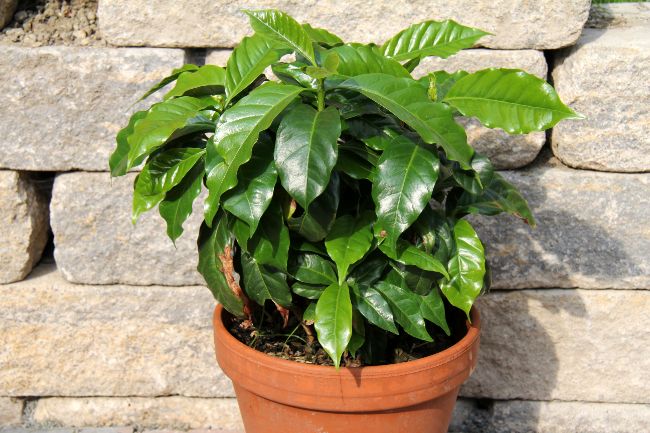
Indoor Coffee Plant Care Tips
- Coffee Plant leaves are thin and rather tender, so don’t handle them roughly. Keep them out of the way of foot traffic.
- Don’t fertilize immediately after repotting; let the roots recover.
- Gently clean the leaves with a damp cloth to help them breathe freely and reduce pests. It also brings out the gloss!
- Consider mulching your Coffee Plant to optimize soil moisture.
- To encourage flowers on a mature plant, reduce watering to a minimum over the winter and increase in early spring.
- Small Coffee Plants are often sold with several plants in one pot for a bushier display, but they will become overcrowded as they grow. Separate the young plants by placing their shared rootball in a bowl of water overnight. They should come apart easily; plant each in an individual small pot.
Toxicity
Coffee Plants are poisonous to humans and animals – the coffee bean is basically the only part that isn’t toxic. Common symptoms of mild Coffee Plant poisoning include diarrhea and nausea; more severe signs are seizures and heart irregularities.
Varieties
Coffea arabica is the most famous member of its family, but there are over a hundred different coffee species. The lesser-used robusta species has harsher-tasting berries but is more resistant to a hot climate. It may be coming soon to a coffee cup near you.
Many varieties of Coffea arabica have been developed from two main types:
Typica – An older variety with a sweet flavor.
Bourbon – Pronounced “bor-BONN,” this type features chocolate and fruit flavors.
A dwarf variety called the Coffea arabica ‘Nana’ is a popular choice for a houseplant: it grows just a few feet tall.
Pests And Diseases
Coffee Plant care indoors can be impacted by all the usual baddies: whitefly, scale, aphids, thrips, mites, and mealy bugs. Inspect the plant regularly to catch infestations early.
Single pests can be killed with a quick wipe of rubbing alcohol. If a group has settled down to feast at your plant’s expense, use the same remedy you’d use for any of your houseplants. Two weeks of regular, thorough spraying with a horticultural soap mixture can ward off an attack.
You can escalate treatment if the bugs are coming on strong, but try to be gentle. The coffee plant’s thin leaves can be sensitive, and the last thing you want is to further damage and weaken the foliage. Read my guide to identifying and treating houseplant pests for all the info you need.
Pro Tip: Test your treatment on a single leaf first to make sure the plant doesn’t react poorly.
Pests are no fun, but disease can be a heartbreaker. One specific ailment, Coffee Leaf Rust (CLR), is ravaging Coffee Plants around the world. The disease doesn’t kill the plants directly, but it greatly weakens their system.
CLR causes oily spots that turns color from yellow to bright orange to red and finally brown, ultimately making the foliage wither and drop off. It also creates dark, soft lesions on the berries.
A copper-based fungicide is the recommended treatment for CLR, but there’s no consistently effective solution to an advanced case; the best protection is prevention. Spray fungicide as a prophylactic measure, promptly harvest ripe berries, and remove any affected branches.
Coffee Plant Care Problems
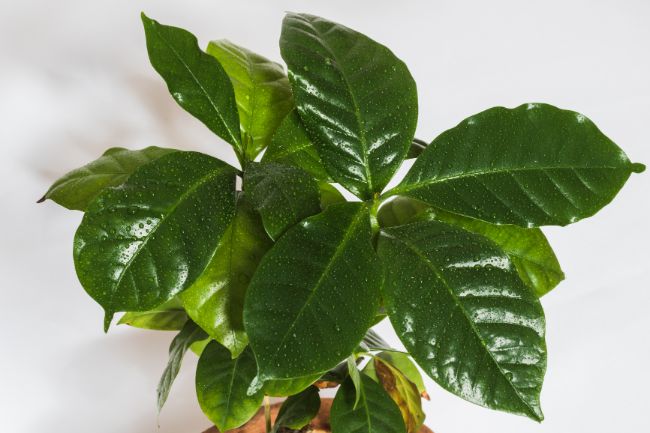
Brown Leaf Spots
The leaves of your Coffee Plant will show brown patches if it’s not getting enough water. They use a good bit of water, especially in warm weather, and need to be thoroughly soaked each time you water. Don’t wait for it to wilt!
Note: Yellowing leaves are a sign of overwatering.
Leaf Loss
Occasional leaf loss is normal, but investigate more closely if you see an increase. Fluctuating temperatures or drafts are a common cause of sudden shedding. Soggy soil is another trigger for drastic loss.
Review your care routine and the plant’s environment. The plant could be losing leaves to a number of factors … or a combination of different ones:
- Reduction in light
- Chronic underwatering
- Low humidity
- Rootbound conditions
- Poor water quality
- Transplant shock
- Recent relocation
- Under or overfertilization
- Pest/disease infestation
How to Harvest and Prepare Your Coffee Berries
Though a single specimen won’t supply much coffee, it’s a fun project! You’ll need about 15 beans for a single cup.
Here’s how:
- A coffee berry is ready to be harvested when it turns deep red. Twist them off. The berries don’t all ripen at the same time, so monitor the plant and remove the berries as they are ready.
- Skin the berry. You can wash the fruit pulp from the seeds or let it dry and include it in the brewing process. Note: Some aficionados suggest fermenting the beans until the pulp falls off, which takes a few days. This is said to make a smoother beverage.
- Let the beans air-dry for one to three weeks. They are ready when the thin outer skin flakes off easily.
- Roast the beans for 10 minutes at 400ºF (200ºC). They pop as they cook and will be brown when ready.
- Grind 12 to 72 hours after roasting – not before!

